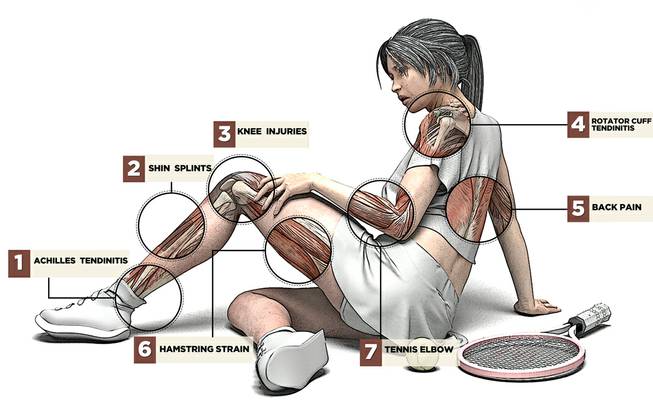
William Neff
Monday, July 13, 2015 | 2 a.m.
Related stories
Sooner or later, most of us realize we aren’t professional athletes. The lightbulb often goes off when bones start cracking or muscles pulling.
Acute injuries occur suddenly and typically are obvious to spot — say, a broken bone or bad sprain accompanied by extreme swelling and severe pain. Chronic injuries develop over time and are more nagging. Symptoms typically include mild swelling, tenderness, dull aches when you rest and pain when you play.
Here are the most common weekend warrior complaints.
1. ACHILLES TENDINITIS
Heel pain, inflammation and swelling at the back of the ankle where the Achilles tendon connects the calf muscles to the heel.
Cause: The injury is common among new runners and middle-age people who play sports or engage in athletic activities only sporadically. Tendinitis is not the same as Achilles tendinosis, which is more chronic and results from muscle tears.
Prevention: Because Achilles tendinitis can be caused by a lack of flexibility and flat feet, stretching and proper footwear are key to preventing injury.
Treatment: Though severe cases of Achilles tendinitis can require surgery, most people recover by resting their ankles and using ice to reduce swelling. Using a heating pad in between icings also can improve tendon performance. More severe injuries could require a cast.
2. SHIN SPLINTS
A common injury for runners and speed walkers, shin splints cause pain in the front lower or inner leg near the shinbone.
Cause: Nobody’s exactly sure, but a lot of pounding with inadequate preparation and stretching can produce them. Collapsed arches from flat feet also can contribute.
Prevention: Invest in well-padded, well- structured footwear. Warm up before you exercise, and focus on stretching your legs.
Treatment: Rest, ice and anti-inflammatory painkillers are the recommended course of action for temporary relief. Keep in mind, however, that other problems, including stress fractures, could cause similar symptoms, so visit your doctor if symptoms don’t get better.
3. KNEE INJURIES
The knee is a complicated and injury-prone joint. Ligaments, cartilage and the kneecap (patella) all can suffer damage.
Cause: Impact or twisting, overuse or even everyday use.
Prevention: Stretching and better overall muscle tone may help, but some doctors consider knee wear and tear inevitable.
Treatment: Ranges from simple rest for patellofemoral pain (”runner’s knee”) to major surgery for ligament or cartilage damage.
4. ROTATOR CUFF TENDINITIS
Inflammation of (or small tears in) the muscles and tendons that attach and stabilize the shoulder bones and joints.
Cause: Sports that require continual arm movements, such as tennis, baseball, swimming and weightlifting, can contribute, as can sleeping on the same arm every night. Symptoms include pain when lifting your arm up or down, pain in the shoulder region and discomfort above the elbow.
Prevention: Avoid repetitive shoulder movements whenever possible. Strength training can help prevent injury.
Treatment: Typically includes ice and anti-inflammatory painkillers. A torn rotator cuff, however, may require surgery.
5. BACK PAIN
Seventy percent of the working population suffers from back pain, according to the American Orthopaedic Society for Sports Medicine. That’s a lot of hurting.
Cause: Failing to warm up properly, too much twisting, heavy lifting and sudden movements can tear or stress delicate back muscles.
Prevention: Proper warmup before exercise, as well as proper care when lifting heavy objects (use your knees, not your back). High heels also can place stress on the lower back.
Treatment: See a doctor if aching persists for more than three days. A physician can perform an MRI or X-ray to determine the exact type of back injury you suffered.
6. HAMSTRING STRAIN
Hamstrings include a group of three muscles which, when stretched, is prone to injury or tearing.
Cause: Lack of proper stretching technique, weak leg muscles and growth spurts all can lead to hamstring strains.
Prevention: Proper stretching and warmup. And if you do feel a strain, give the muscles lots of time to recover.
Treatment: Includes resting the leg, elevating it, icing it and compressing it. Surgery could be required if the injury is severe.
7. TENNIS ELBOW
The name can be misleading since both tennis and golf players — as well as anyone who moves his or her arm repetitively while gripping an object — can suffer this injury.
Cause: Overexertion of tissues and tendons near the bony part of the elbow. It frequently occurs in a person’s dominant arm but can affect either appendage.
Prevention: Use proper equipment when exercising and loosen your grip.
Treatment: Physical therapy, forearm bracing, anti-inflammatory gels and cortisone shots. Though tennis elbow most often is treated at home, it’s important to see a doctor if your elbow begins to swell, can’t be moved normally or doesn’t improve within a couple of weeks.
HELP AND ADVICE
It may have a tongue-twister name, but the National Institute of Arthritis and Musculoskeletal and Skin Diseases also has a handy PDF you can download that’s loaded with information and advice concerning these and other common sports injuries.

Join the Discussion:
Check this out for a full explanation of our conversion to the LiveFyre commenting system and instructions on how to sign up for an account.
Full comments policy